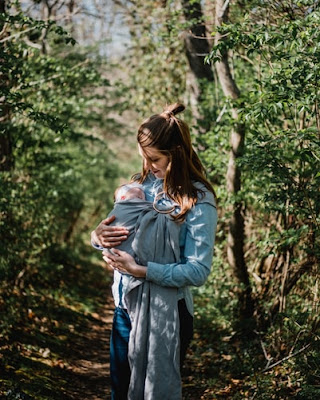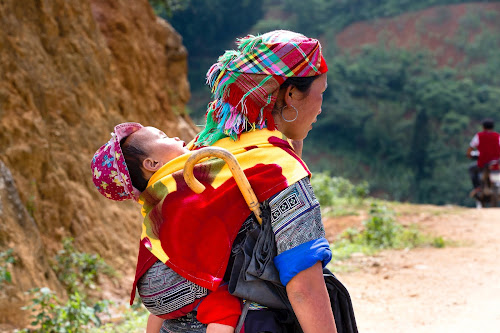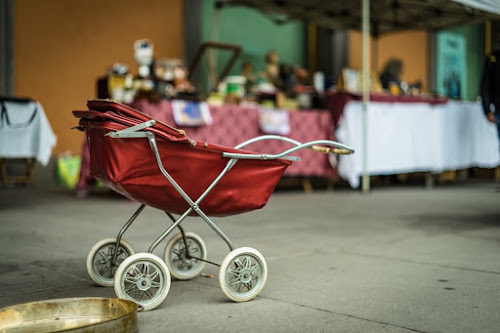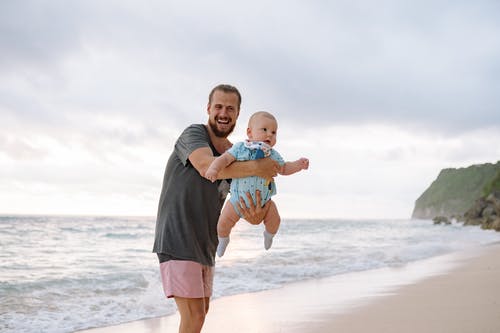Baby carrier
Baby wearing is the practice of wearing or carrying a baby in a sling or in another form of carrier. Baby wearing has been practiced for centuries around the world. In the industrialized world, baby wearing has gained popularity in recent decades.
Benefits
·
In the wearing of newborns in particular, the
mothers' Oxycontin levels are increased through the physical
contact with the infant, leading to a more intimate maternal bond, easier breastfeeding and better care, thus lowering the
incidence of postpartum depression and psychosomatic illness in
the mother; similarly, the father carrying the baby has
benefits for the paternal bond.
· Infants who are carried are generally calmer, as more of their primal/survival needs are met. The caregiver can be seen, heard, smelled, touched, tasted, provide feeding and the motion necessary forcontinuing neural development, gastrointestinal and respiratory health and to establish balance (inner ear development) and muscle tone is constant.
·
Parental rhythms (walking, heartbeat, etc.) can have
balancing and soothing effects on infants.
·
Infants are "humanized"
earlier by developing socially. Babies are closer to people and can study facial expressions, learn languages faster and be familiar with body language.
·
Independence is established earlier.
·
Attachment between child and caregiver is more secure.
·
Decreases risk of positional plagiocephaly ("flat
head syndrome") caused by extended time spent in a car seat and by
sleeping on the back.
Kangaroo care, in which the baby's bare
body rests against the parent's bare chest, with or without a baby sling, has
shown clear benefits to premature and ill infants.
Baby transport
Various methods of transporting children have been used in different cultures and times. These methods include baby carriages , infant car seats, portable bassinets, strollers, slings, backpacks, baskets and bicycle carriers.
A baby sling or baby carrier is a piece of cloth that supports an infant or other small child from a carer's body. The use of a baby sling is called baby wearing.
Types
Ring slings
Man wearing
child in a ring sling
These are baby carriers that use dynamic tension, a length of cloth and metal (such as aluminum) or nylon rings. One end of the cloth is sewn to two rings. The cloth wraps around the wearer's body from shoulder to opposite hip and back up to the shoulder, and the end is threaded through the rings to create a buckle effect.
The baby sits or lies in the resulting pocket. Once a sling is threaded, it can be taken off and put back on without retreading. A threaded sling forms a loop of cloth. The wearer can put one arm and the head through the loop of cloth to put the sling back on.
When the baby is in the carrier, the baby's weight puts tension on the fabric, and the combination of fabric tension, friction of fabric surfaces against each other and the rings combine to "lock" the sling in position.
This type of sling can adjust to different wearers' sizes and accommodate different wearing positions easily: the wearer supports the baby's weight with one hand and uses the other hand to pull more fabric through the rings to tighten or loosen the sling.
Ring slings may be padded or unpadded at the shoulder, have padded or unpadded edges or "rails", and the "tail" of the sling may be open or closed. Some "hybrid" ring slings have curved seats sewn into the body, similar to the seam in a pouch.
Ring slings are most closely related in use to the Mexican rebozo, the rings take the place of the knot.Variation is also found in how the rings attach to the cloth, commonly referred to as "shoulder style". Basic shoulder styles include gathered, pleated, "hot dog" or "center fold", pouch-style (folded in half) and many variations.
Sisters
wearing baby dolls in play slings
Ring slings are highly adaptable and most care givers can wear a "one size fits most" size. As long as the tail is about 8" long a ring sling is still considered safe.
Tail length is decided by personal preference with most preferring the tail to hit about hip or mid thigh.The recommended maximum weight limit for wearing baby in a ring sling is up to 35lbs.
Pouch slings
Sometimes called "tube", "pocket" or "ring less" slings, these are generally formed by a wide piece of fabric sewn into a tubular shape. Simple, or fitted pouches do not have rings or other hardware. Adjustable pouches may adjust with zippers, snaps, buckles, clips, rings, drawstrings, Velcro, and other methods.
Wraps
Wraps (sometimes called "wraparounds" or "wraparound slings") are lengths of fabric (usually between 2 metres and 6 metres, or 2.5–7 yards long, and 15–30 inches wide), which are wrapped around both the baby and the wearer and then tied.
There are
different carrying positions possible with a wrap, depending on the length of
the fabric. A baby or toddler can be carried on the wearer's front, back or
hip. With shorter wraps it is possible to do a one-shouldered carry, similar to
those done with a pouch or a ring sling, although most carries involve the
fabric going over both shoulders of the wearer and often around the waist to
offer maximum support.
There are two main types of wrap—stretchy and woven. Stretchy wraps are generally made of knits such as jersey or interlock. It is easy to take babies in and out of a stretchy wrap. This can be easier for the wearer as the sling often remains tied on and the baby is lifted out and put back in as required.
Natural fibers are usually chosen, with cotton being the most
common, but hemp, linen, silk and wool are also used. A variety of weaves are
used. Most common are homespun or handwoven fabrics with simple over-under
weaves, twills and jacquard s. Most weaves provide some give or stretch
diagonally.
Simple pieces of cloth
Pieces of cloth can be turned into slings by wrapping the fabric around the carrier and the baby and either tying it with knots or using a twist and tuck method to secure the ends.
Rebozos (Mexico), mantas (Peru), Kansas (Africa)
and selendangs (Indonesia) are all rectangular pieces of cloth but are tied or
wrapped in many different ways. Wraps are also simple pieces of cloth.
Child carrier
The entry for "baby sling" contains comprehensive information about different types of carriers. It would seem logical to remove that information from "baby sling" and bring it over to this entry on "child carrier" and even consider renaming this entry "baby carrier" as that seems to be a more common term.
"Baby sling" is a type of child carrier, most commonly one with fabric and rings, but it can also be tied. But there are many different carriers described in that article, including historical carriers and carriers used in different cultures.
Those paragraphs would seem to fit "child carrier" better, along with new material that would include modern front pack and backpack carriers.More research would need to be done to fill in the gaps left in the "baby sling" entry.
For example, what constitutes a sling? Is it a carrier that would only be worn over one shoulder like a sash? Would a hiking carrier that uses buckles or clips to secure the child to the wearer fit in the sling category or the "child carrier" category?

































































